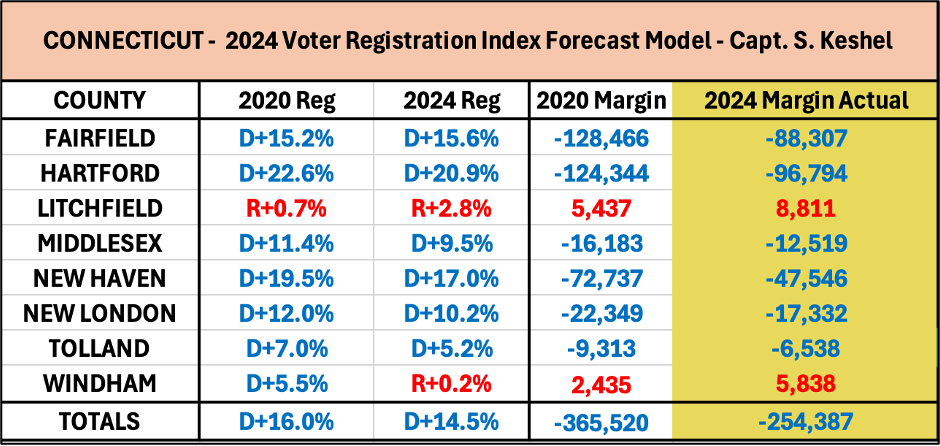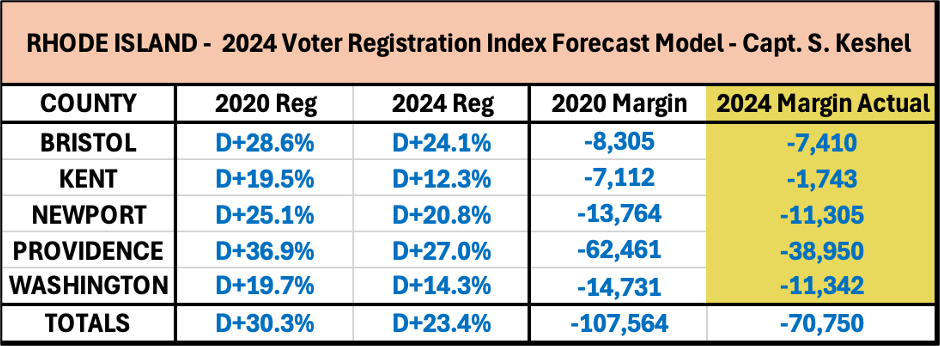New England 2024 Presidential Election Review
Author’s Note: For the in-depth review of New Hampshire’s 2024 presidential race, please click here. As a battleground, it warrants a more extensive and separate review than more easily decided states.
This portion of the 2024 Election Compendium will focus on the remaining New England states of Connecticut, Maine, Massachusetts, Rhode Island, and Vermont.
Outcomes
Connecticut Harris +14.5%
Maine Statewide Harris +7.1%
· Maine’s 1st C.D. Harris +21.8%
· Maine’s 2nd C.D. Trump +9.0%
Massachusetts Harris +24.8%
Rhode Island Harris +13.9%
Vermont Harris +31.8%
Connecticut Harris by minimum of 14.0%
Maine Statewide Harris by 4.0%
· Maine’s 1st C.D. Harris by minimum of 15.0%
· Maine’s 2nd C.D. Trump by minimum of 10.0%
Massachusetts Harris by minimum of 30.0%
Rhode Island Harris by minimum of 12.0%
Vermont Harris by minimum of 30.0%
Preface
New England used to be overwhelmingly Republican, and even after Massachusetts and Rhode Island became tougher states for GOP presidential nominees to win, Connecticut, Maine, Vermont, and New Hampshire were all reliably Republican. In fact, prior to 1992, Democrat presidential wins of Maine, Vermont, or New Hampshire were practically once-in-a-lifetime events. Today, Maine has the only Republican member of the U.S. Congress (Senator Susan Collins) out of the entire New England region.
New Hampshire’s presidential race and drastically improved Trump losing margins elsewhere aside, the only potential surprise worth monitoring in New England was the presidential race in Maine. That state is one of two (along with Nebraska) that splits its electoral votes, which it has done since 1972, and the three Trump elections represent the only occasions on which those votes have split between major party nominees (Trump carried the 2nd Congressional District in all three of his runs). I did not predict Trump to carry any state in New England, and maintained for the duration of the cycle that only 7 electoral votes for Trump were up for grabs in the region (New Hampshire’s four, and three out of four in Maine).
Vermont is the only state in the region that does not register its voters by party. The other five all had shifts toward the Republican Party in registration, suggesting progress for Trump and influencing my predictions:
· Connecticut from D+16.0% in 2020 to D+14.5% in 2024
· Maine from D+7.3% in 2020 to D+6.0% in 2024
· Massachusetts from D+22.0% in 2020 to D+17.9% in 2024
· New Hampshire from D+1.3% in 2020 to R+4.3% in 2024
· Rhode Island from D+30.3% in 2020 to D+23.4% in 2024
Analysis
· As discussed in the New Hampshire specific post, Trump improved in all 10 counties, which all improved by registration toward the GOP. The party registration indicator was 10 for 10 in predicting the trajectory of elections in the Granite State.
· In Connecticut, Trump improved in all 8 counties. 7 had shifts toward the GOP in registration, and the one that didn’t (Fairfield) still improved for Trump because Harris dumped more than 10% of Biden’s 2020 ballot count. The party registration indicator was 7 for 8 in Connecticut.
· In Maine, 11 of 16 counties favored the GOP since the 2020 election by registration. Trump improved in all 11 of those. Of the 5 counties favoring Democrats since the 2020 election (of which 4 were in Maine’s 1st Congressional District), only 2 presented an improved Harris margin. Trump improved in Cumberland, Hancock, and Knox, despite the shift toward Democrats in registration (note: Trump lost Cumberland by more votes than he did in 2020, but by a slightly reduced percentage). The party registration indicator was 13 for 16 in predicting Maine’s county shifts, and on face value, signaled trouble for incumbent Democrat U.S. House Representative Jared Golden in Maine’s 2nd Congressional District.
· Even in deep blue Massachusetts, Trump improved in all 14 counties. This may come as no surprise, but all 14 counties shifted more Republican in registration since 2020, which means the party registration indicator was a perfect 14 for 14 in the Bay State, where Trump cut almost 340,000 in Democrat margin of victory from four years ago.
· Finally, Massachusetts’ perma-blue cousin, Rhode Island, also saw all its counties (5) shift more Republican since 2020. The party registration indicator was again a perfect 5 for 5 in predicting Rhode Island’s drift by county.
· Party registration indicator in states registering by party (all but Vermont) was 49 for 53 in predicting election shifts at the county level. The four misses all shifted Democrat by registration, but moved toward Trump by percentage, meaning no indications of election manipulation favoring Democrats would present from a deviation between party registration and result.
· Harris lost votes from Biden’s totals in 57 of 67 New England Counties (New Hampshire included). In Suffolk (core Boston) and Hampden (Springfield) Counties in Massachusetts, she had fewer votes than Hillary Clinton did eight years ago. Harris failed to gain over Biden’s totals in a single county in Massachusetts, Rhode Island, Vermont, and Connecticut, lending credence to all theories about ballot stuffing and mail fraud in the 2020 election. She managed to narrowly surpass Biden’s statewide ballot count in Maine, although she won by a reduced margin from four years ago there.
· All in all, Harris lost 548,464 in margin of victory out of all New England from Biden’s 2020 margins. Trump won national bellwether Essex County in Vermont and flipped neighboring Orleans County for the first GOP presidential win there since 2000. Harris’ biggest crash was felt in Massachusetts, with a margin loss of 339,773 in four years, where Trump came within 2 points of winning Bristol County, which would have been the first GOP presidential win of a county in Massachusetts since 1988. Trump flipped Kennebec County, Maine, which he also won in 2016.
· Notable county collapses by Harris that underscore likely 2020 election fraud: Essex, Hampden, Middlesex, Norfolk, Plymouth, Suffolk (well below Hillary Clinton’s 2016 totals), Worcester Counties in Massachusetts; Providence and Kent Counties, Rhode Island; Fairfield, Hartford, New Haven Counties, Connecticut.
· I listed my concerns with New Hampshire’s 2020 and 2024 elections in its own article, and I am skeptical about Harris’s selective vote gains in Maine, especially in the northern counties, which all (except for Hancock County) had registration gains favoring the GOP. Golden managed to hang on to his seat despite Trump’s 9.0% win in ME-2, edging out Austin Theriault in Ranked Choice Voting by 2,706 votes in the Final Round of tabulation (after both finished short of a majority with Golden leading by a measly 623 out of nearly 400,000 cast in the First Choice Round). Harris had almost no votes gained in any counties outside of Maine, save for three small gains in eastern New Hampshire, and Maine was the only state in all New England with more Harris votes than Biden votes. I suspect Congressman Golden retained his seat through extensive harvesting of mail-in ballots attached to abundant registrations spawned by Automatic Voter Registration. This brings Waldo and Penobscot (metro Bangor) Counties under scrutiny. Notably, Harris wound up below Clinton 2016 levels in remote Aroostook County, which is the only such county in Maine to position her below Clinton. This suggests ballot harvesting efforts did not pay off or were not attempted in such a remote county, and the resulting shift in vote margin stands out as it should have elsewhere if not otherwise impeded.
Opportunities for Election Manipulation
I profiled New Hampshire’s specific vulnerabilities in the linked piece within this article. Something notable about New England’s elections is that they are largely conducted and reported by township and therefore counts are much quicker and less prone to cheating over drawn-out periods. Here is a thorough listing of known deficiencies in New England’s elections:
Keep reading with a 7-day free trial
Subscribe to Captain K's Corner to keep reading this post and get 7 days of free access to the full post archives.










